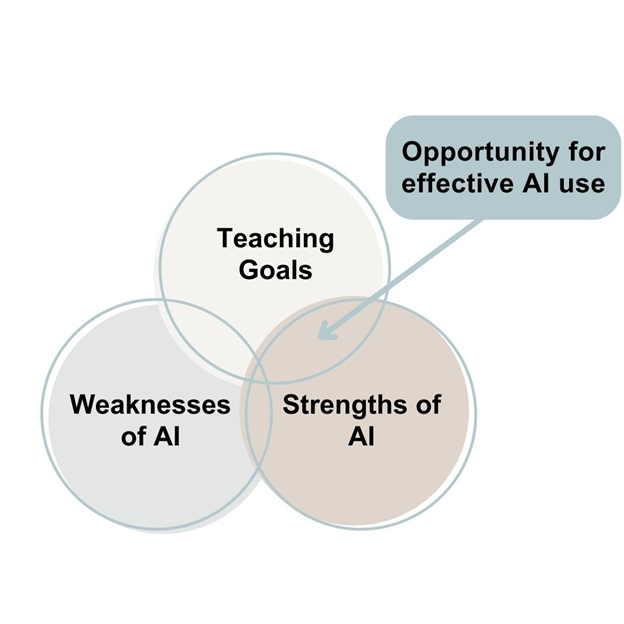Generative AI tools such as ChatGPT, Microsoft Copilot (formerly Bing Chat), Claude, LLaMA and others can be powerful tools for teaching and designing learning experiences for your students. When used appropriately, these tools can help develop course objectives, create activities, generate ideas for assessments and more. Harnessing the strengths of generative AI may help you perform certain teaching tasks more efficiently, giving you the opportunity to devote more time to other teaching activities. It may also help you to brainstorm ideas for new teaching materials or help you improve or modify existing materials. On this page, we describe some general strategies for using Generative AI to create meaningful learning experiences for students.
How can I use generative AI in course development and design?
While generative AI can be a powerful tool in your teaching toolbox, it may not always be the best or most appropriate tool. In some cases, using generative AI and revising the content it produces may be more time-consuming than using a more traditional method. Before using generative AI for a particular task, consider the following questions:
- What are my current teaching needs and goals?
- Where do my needs and goals intersect with the current strengths of generative AI?
- How will I mitigate the current weaknesses of Artificial Intelligence when using generative AI and what ethical issues might I encounter?
In general, generative AI will be most useful to your teaching when your needs intersect with its strengths and when you can mitigate its weaknesses.

Aligning teaching goals, effective pedagogy and generative AI use
When incorporating generative AI into your teaching, it can be helpful to connect the technology to effective pedagogical strategies. By starting with a specific strategy or goal in mind, this can help bring purpose and direction to your use of generative AI.
To get started, you might consider asking yourself one or more of the following questions:
How can I use generative AI to…
- clarify learning goals and objectives in my course?
- create more opportunities for active learning?
- reduce my students’ cognitive load?
- chunk and scaffold course material?
- develop meaningful assessments?
- strengthen student engagement?
Navigating the strengths and weaknesses of generative AI
To determine when generative AI may help you achieve a particular instructional goal, you may want to consider its strengths and weaknesses:

In some cases, your teaching needs may not align with the strengths of generative AI. For example, while you may need additional help with providing qualitative feedback on student writing, generative AI may not have the subject matter expertise to provide accurate feedback. Moreover, many generative AI programs have unknown privacy and data usage policies; as such, entering student data into certain generative AI programs may violate student privacy protections such as FERPA. For more guidance on navigating the strengths and weaknesses of generative AI, see our Tips on Using Generative AI page.
Four strategies for using generative AI in course design and development
Once you have a clear goal in mind and have considered the strengths and weaknesses of using generative AI to achieve this goal, you’ll want to consider how you will you use generative AI to get meaningful output. In this section, we share examples of four input prompt patterns that may help meet your teaching goals and needs. Prompt patterns are essentially strategies that help you to tailor the type and style of input you receive from a generative AI program. You can use them like a template or a formula, using pre-scripted phrases and adding in specific details when required. This section provides the format of a suggested pattern along with example prompts that demonstrate how you might use the pattern in your teaching. For more information on prompt patterns, visit our Prompt Patterns page and Vanderbilt University Professor of Computer Science Jules Whites’ free, self-paced Prompt Engineering course.
When using these four strategies, it is worth remembering that using these patterns may be just a part of your interaction with generative AI. For example, you may want to provide feedback on the outputs, refine your prompt, or request additional information. Remember that many generative AI programs allow you to incorporate and introduce new information to the program. For more tailored responses, you may want to provide information related to your course, such as excerpts from your syllabus, an assignment prompt, or a list of course objectives. For more information on how to introduce new information to a LLM, see this video:
-
The descriptions of prompt patterns in the 'Four Strategies for Using AI in Course Design and Development' are taken from readings provided in Vanderbilt University Professor of Computer Science Jules White’s Prompt Engineering course on Coursera and are reproduced here with his permission.
Additionally, we consulted the following works in the development of this webpage. For additional perspectives on these topics, we encourage you to review the sources linked above.